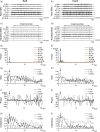Coordinated features in jaw and neck muscle activities induced by chewing of soft and hard gum in healthy subjects
- PMID: 33687150
- PMCID: PMC8543462
- DOI: 10.1002/cre2.413
Coordinated features in jaw and neck muscle activities induced by chewing of soft and hard gum in healthy subjects
Abstract
Backgrounds: Jaw and neck muscles may be activated by chewing load using a hard food. However, it remains unclear how effects the gum hardness to the coordinated features in jaw and neck muscle activities during chewing performance.
Objectives: This study was conducted to quantitatively elucidate the effects of the hardness of the gum on coordinated features in jaw and neck muscle activities using intermuscular EMG-EMG transfer function and EMG-EMG coherence function analyses in 18 healthy subjects.
Methods: Jaw and neck muscle activities were aggregated into the first peak frequency of the power spectrum, and power, gain, phase, and coherence parameters between jaw and neck muscle activities were examined in the first peak frequencies during soft and hard gum chewing.
Results: The first peak frequency was not significantly different between soft and hard gum chewing. In contrast, power values of the jaw and neck muscles were significantly increased by chewing of hard gum as compared with soft gum, whereas gain, phase, and coherence were not significantly changed by gum hardness.
Conclusions: The chewing rhythm, the quantitative and temporal coordination, and the functional coordination in jaw and neck muscle activities were not changed during soft and hard gum chewing, as well as increased jaw and neck muscles activities. It is therefore concluded that the chewing rhythmicity and jaw and neck muscles coordination accompanied with the increased jaw and neck muscle activities are maintained under the condition of the chewing load using gum hardness in the healthy individuals.
Keywords: chewing gum; masticatory muscles; masticatory systems; neck muscles; surface electromyography.
© 2021 The Authors. Clinical and Experimental Dental Research published by John Wiley & Sons Ltd.
Conflict of interest statement
Takeshi Uchida and Ikuo Kantake are employed by Dental Support Co. Ltd. Neither has any potential conflicts of interest to declare with respect to research, authorship, and/or publication of this article. The remaining authors declare that the research was conducted in the absence of any commercial or financial relationships that could be construed as a potential conflict of interest.
Figures




Similar articles
-
Evaluation of jaw and neck muscle activities while chewing using EMG-EMG transfer function and EMG-EMG coherence function analyses in healthy subjects.Physiol Behav. 2016 Jun 1;160:35-42. doi: 10.1016/j.physbeh.2016.03.023. Epub 2016 Apr 5. Physiol Behav. 2016. PMID: 27059322
-
Effects of denture wearing on coordinated features of jaw and neck muscle activities during chewing in partially edentulous elderly patients.J Prosthodont Res. 2021 Jun 30;65(2):235-242. doi: 10.2186/jpr.JPR_D_20_00004. Epub 2020 Oct 9. J Prosthodont Res. 2021. PMID: 33041278
-
Changes in jaw and neck muscle coactivation and coordination in patients with chronic painful TMD disk displacement with reduction during chewing.Physiol Behav. 2021 Mar 1;230:113267. doi: 10.1016/j.physbeh.2020.113267. Epub 2020 Nov 24. Physiol Behav. 2021. PMID: 33246001
-
Increased sternocleidomastoid, but not trapezius, muscle activity in response to increased chewing load.Eur J Oral Sci. 2013 Oct;121(5):443-9. doi: 10.1111/eos.12066. Epub 2013 Jun 26. Eur J Oral Sci. 2013. PMID: 24028592
-
Development of the jaw sensorimotor control and chewing - a systematic review.Physiol Behav. 2018 Oct 1;194:456-465. doi: 10.1016/j.physbeh.2018.06.037. Epub 2018 Jun 28. Physiol Behav. 2018. PMID: 29960013
References
-
- Carter, G. , Knapp, C. , & Nuttall, A. (1973). Estimation of the magnitude squared coherence function via overlapped fast Fourier transform processing. IEEE Transactions on Audio and Electroacoustics, 21, 337–344.
-
- Ehara, T. , Ogawa, Y. , Kato, J. , Aoki, K. , Ogawa, S. , & Iwasaki, K. (2012). The effect of dexmedetomidine on arterial‐cardiac baroreflex function assessed by spectral and transfer function analysis. Journal of Anesthesia, 26, 483–489. - PubMed
-
- Eriksson, P. O. , Häggman‐Henrikson, B. , Nordh, E. , & Zafar, H. (2000). Co‐ordinated mandibular and head‐neck movements during rhythmic jaw activities in man. Journal of Dental Research, 79, 1378–1384. - PubMed
-
- Eriksson, P. O. , Zafar, H. , & Nordh, E. (1998). Concomitant mandibular and head‐neck movements during jaw opening‐closing in man. Journal of Oral Rehabilitation, 25, 859–870. - PubMed
Publication types
MeSH terms
Grants and funding
LinkOut - more resources
Full Text Sources
Other Literature Sources

